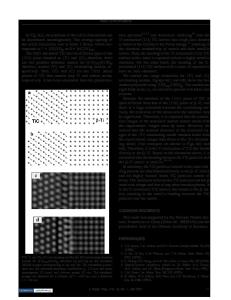Interface characterization of ceramic fiber-reinforced ti alloy composites manufactured by infrared processing
- PDF / 9,220,780 Bytes
- 16 Pages / 597.28 x 777.28 pts Page_size
- 74 Downloads / 334 Views
I.
INTRODUCTION
TITANIUM matrix composites are candidates for applications in the aerospace industry primarily because of their high specific strength and modulus, good dimensional stability, and retention of strength at elevated temperatures. These composites are primarily fabricated by solid-state diffusion bonding processes such as vacuum hot pressing or hot isostatic pressing, t~,2,31 However, shape limitations and high costs caused by pressurizing and vacuum requirements make diffusion bonded composites expensive materials. Liquid infiltration is a relatively low cost technique for fabricating metal matrix composites. However, because of severe reactions between liquid titanium and reinforcing fibers during fabrication, this technique has not received much attention in the manufacture of titanium matrix composites. Tolouit4] attempted to produce carbon fiber-reinforced titanium alloy composites using an induction heating source. Composites fabricated by him revealed severely degraded fibers and poor mechanical properties. Nourbakhsh et al.[51 prepared A1203 fiber-reinforced TiA1 composites using liquid-state pressure infiltration. Due to the large activity of aluminum in the alloy, interfacial reactions in the A1203/TiA1 system were not severe and, as a result, AI203 fiber-reinforced TiA1 composites could be made with in-
S.G. WARRIER, formerly Postdoctoral Fellow, Department of Materials Science and Engineering, University of Cincinnati, is Research Scientist, Systran Corp., Dayton, OH 45433. S.H. CHEN, Graduate Student, and S.K. WU, Professor, are with the Institute of Materials Science and Engineering, National Taiwan University, Taipei, Taiwan 10764. R.Y. LIN, Professor, is with the Department of Materials Science and Engineering, University of Cincinnati, Cincinnati, OH 45221. Manuscript submitted March 30, 1994. METALLURGICAL AND MATERIALSTRANSACTIONS A
duction heating furnaces using pressure infiltration. No other attempts to fabricate ceramic fiber-reinforced titanium alloy composites by the liquid infiltration technique have been reported. It appears that limiting the reaction between the reinforcement and the molten matrix is one of the most crucial factors in the success of metal matrix composite fabrication. Among several approaches that may be taken to reduce interracial reaction during liquid infiltration, shortening the processing time and providing protective coatings on the reinforcement fibers appear to be most feasible. A rapid infrared manufacturing (RIM) process has been developed to minimize the processing time for infiltration.tr-H] This process comprises heating at rates on the order of 100 ~ to 200 ~ both the alloy and the fibers in an infrared furnace under an argon atmosphere. The entire composite fabrication process is typically completed in only 1 to 2 minutes as opposed to several hours in conventional diffusion bonding processes. Since the total time that the liquid alloy remains in contact with the fiber preform is very short, reactions at the fiber-matrix interface can be e
Data Loading...











